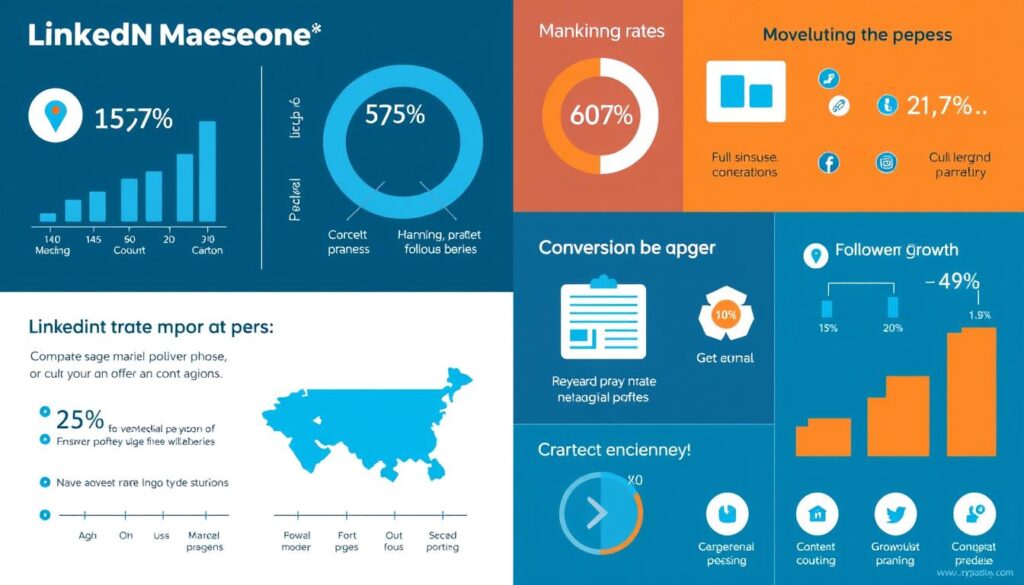LinkedIn has become a crucial platform for B2B companies, offering unparalleled opportunities to connect with decision-makers and grow their business. With over 930 million users in 200+ countries, 80% of whom are in decision-making roles, LinkedIn is the epicenter of professional social media activity. This makes it an ideal space for B2B professionals to market, network, and connect. A well-planned LinkedIn B2B marketing strategy can help companies tap into this vast potential, leveraging the platform’s unique features to drive lead generation and business growth.
A successful LinkedIn B2B marketing strategy involves a combination of effective content creation, engagement, and networking. By focusing on job titles that align with decision-making power and crafting a striking company page, businesses can attract and retain the attention of their target audience. Using SEO practices and targeting keywords on LinkedIn company pages can also bring in qualified leads. As a valuable tool for lead generation, LinkedIn enables B2B companies to promote their products and services to a targeted audience, making it an essential component of any B2B social media strategy.
By incorporating LinkedIn into their overall B2B social media strategy, companies can expand their reach, build credibility, and drive business results. With 97% of B2B business’ social media leads coming from LinkedIn, it’s clear that this platform is a critical channel for B2B marketing. Whether it’s through regularly posting engaging content, participating in industry-related groups, or using automation tools to streamline outreach efforts, LinkedIn offers a range of opportunities for B2B companies to connect with their target audience and achieve their marketing goals.
Table of Contents
Key Takeaways
- LinkedIn is a critical channel for B2B marketing, with 97% of B2B business’ social media leads coming from the platform.
- A well-planned LinkedIn B2B marketing strategy can help companies drive lead generation and business growth.
- Focusing on job titles that align with decision-making power is crucial for targeting audiences on LinkedIn.
- Using SEO practices and targeting keywords on LinkedIn company pages can bring in qualified leads.
- Regularly posting engaging and informative content on LinkedIn can retain the audience and drive business results.
- LinkedIn is an essential component of any B2B social media strategy, offering unparalleled opportunities to connect with decision-makers and grow business.
Understanding LinkedIn’s B2B Marketing Potential
LinkedIn has become a crucial platform for B2B marketing, with a vast user base of over 930 million members globally. The platform’s continuous growth, with three new members joining every second, makes it an attractive space for businesses to establish their presence. Approximately 80% of LinkedIn members hold decision-making roles within their companies, making it an ideal platform for B2B companies to connect with potential clients and partners.
The LinkedIn B2B success rate is a testament to the platform’s effectiveness in facilitating business relationships and driving growth. With 97% of B2B social media leads coming from LinkedIn, it’s clear that the platform is a hub for B2B decision-makers on LinkedIn. The best time to post on LinkedIn for optimal engagement is during typical working hours, with peak times being 10 a.m. to 12 p.m. on Tuesday to Thursday.
Some key statistics that highlight LinkedIn’s B2B marketing potential include:
- 80% of LinkedIn members hold decision-making roles within their companies
- 97% of B2B social media leads come from LinkedIn
- Three new members join LinkedIn every second
These statistics demonstrate the vast opportunities available for B2B companies on LinkedIn, making it an essential platform for establishing a strong online presence and connecting withB2B decision-makers on LinkedIn.
Building a Professional Company Profile
Creating a professional company profile is essential for establishing credibility and attracting potential clients on LinkedIn. A complete and professional profile serves as your company’s digital storefront, making it crucial to optimize it with relevant keywords for better search visibility. This is where LinkedIn company page optimization comes into play, helping your business stand out in a crowded market.
A well-crafted B2B LinkedIn profile should include a compelling summary, logo, cover image, and contact information. It’s also important to regularly analyze performance using LinkedIn analytics to track engagement, follower growth, and content performance for optimization. By doing so, you can refine your LinkedIn company page optimization strategy to better resonate with your target audience.
To further enhance your profile, consider creating showcase pages to target niche segments of your audience effectively. This will help you tailor your content and messaging to specific groups, increasing the likelihood of engagement and conversion. By leveraging these strategies, you can create a strong B2B LinkedIn profile that drives real results for your business.
Essential LinkedIn Marketing Strategies for B2B Companies
Developing a B2B content strategy is crucial for businesses to succeed on LinkedIn. This involves creating content that resonates with the target audience’s needs and interests. Consistency in posting and providing value are key to successful LinkedIn marketing. By doing so, businesses can increase their visibility and credibility on the platform.
Effective LinkedIn engagement tactics are also vital for B2B companies. This includes interacting with followers and industry peers to boost visibility and credibility. Some strategies for engagement include responding to comments, participating in discussions, and using relevant hashtags. By leveraging these tactics, businesses can build strong relationships with their audience and establish themselves as thought leaders in their industry.
To further enhance their LinkedIn marketing efforts, B2B companies can utilize various tools and features. For example, LinkedIn’s built-in analytics tool provides insights into post performance, allowing businesses to refine their content strategy and improve engagement. Additionally, LinkedIn’s advertising options enable businesses to reach a wider audience and drive traffic to their website.
Leveraging LinkedIn’s Premium Features for B2B Growth
For businesses looking to enhance their B2B marketing efforts on LinkedIn, utilizing LinkedIn Premium for B2B can be a game-changer. One of the key features of LinkedIn Premium is the LinkedIn Sales Navigator, a powerful tool designed to help sales professionals find, connect, and engage with potential leads and accounts more effectively.
With LinkedIn Sales Navigator, businesses can leverage advanced search and filtering options to identify decision-makers within target companies. This allows for more precise targeting and a higher likelihood of converting leads into sales. Additionally, LinkedIn Premium for B2B provides access to detailed analytics, enabling businesses to measure the effectiveness of their campaigns and refine their strategies accordingly.
Some of the benefits of using LinkedIn Premium for B2B include:
- Advanced search and filtering options to identify potential leads
- Access to detailed analytics to measure campaign effectiveness
- Ability to send InMail messages to connect with potential clients
- Enhanced visibility of company pages and posts
By leveraging these features, businesses can supercharge their B2B marketing efforts on LinkedIn and achieve significant ROI. Whether it’s through targeted advertising, content marketing, or sales outreach, LinkedIn Premium for B2B provides the tools and insights needed to succeed in today’s competitive B2B landscape.
| Feature | Benefit |
|---|---|
| LinkedIn Sales Navigator | Advanced search and filtering options |
| Detailed Analytics | Measure campaign effectiveness |
| InMail Messages | Connect with potential clients |
Content Creation Best Practices for B2B Audiences
When it comes to creating B2B LinkedIn content, it’s essential to focus on providing value to your audience. B2B buyers often value content that solves specific business problems and addresses pain points. To achieve this, consider developing thought leadership content that establishes authority in the B2B sector.
A well-planned LinkedIn posting schedule can significantly impact the performance of your B2B LinkedIn content. Data shows that video content on LinkedIn gets 5x more engagement than non-video content, and the best time to post is typically between 10 am to 12 pm, Tuesday to Thursday. By incorporating these insights into your content strategy, you can increase the visibility and effectiveness of your B2B LinkedIn content.
Types of Content that Perform Best
- White Papers/eBooks
- Webinars/Podcasts
- Case Studies
Posting Schedule Optimization
Optimizing your LinkedIn posting schedule can help you reach a wider audience and increase engagement. Consider posting during peak hours, such as between 10 am to 12 pm, Tuesday to Thursday, to maximize your content’s visibility.
Content Distribution Strategies
Effective content distribution is crucial for amplifying the reach of your B2B LinkedIn content. Consider leveraging primary distribution channels such as LinkedIn, Email Marketing, and Industry Publications to get your content in front of the right audience.
| Content Format | Engagement Rate |
|---|---|
| Video Content | 5x higher than non-video content |
| Thought Leadership Content | Establishes authority in the B2B sector |
Building and Nurturing Professional Relationships
Building relationships on LinkedIn is closely tied to building personal brands. By crafting an engaging LinkedIn profile and participating actively in discussions, one can foster authentic relationships and attract suitable professional contacts. Effective LinkedIn networking involves initiating and maintaining professional connections, emphasizing the balance between personal and company branding.
To nurture these relationships, it’s essential to engage with others’ content, participate in group discussions, and leverage LinkedIn’s messaging features. This can include commenting on posts, sharing relevant articles, and sending personalized messages to connections. By doing so, businesses can build trust and establish themselves as thought leaders in their industry, ultimately driving B2B relationship building efforts.
Some strategies for building and nurturing professional relationships on LinkedIn include:
- Sharing valuable and relevant content to attract and engage with potential connections
- Participating in LinkedIn Groups related to your industry to establish yourself as a thought leader
- Utilizing LinkedIn’s messaging features to connect with potential clients and partners
By implementing these strategies, businesses can effectively build and nurture professional relationships on LinkedIn, driving B2B relationship building efforts and ultimately generating new leads and opportunities.
| Strategy | Benefits |
|---|---|
| Sharing valuable content | Attracts and engages potential connections |
| Participating in LinkedIn Groups | Establishes thought leadership and drives engagement |
| Utilizing LinkedIn’s messaging features | Connects with potential clients and partners |
LinkedIn Advertising Options for B2B Companies
LinkedIn offers various advertising options for B2B companies, including sponsored content, message ads, and dynamic ads. These ad formats can be used to reach decision-makers and industry leaders, with precise targeting based on job titles, industries, and company sizes.
One of the most effective ways to use LinkedIn B2B advertising is through sponsored content on LinkedIn. This allows companies to promote their products or services to a targeted audience, increasing brand awareness and driving website traffic. Sponsored content can be used to promote single image ads, carousel ads, video ads, event ads, and document ads.
Some of the benefits of using sponsored content on LinkedIn include:
- Increased brand awareness
- Targeted advertising to decision-makers and industry leaders
- Flexibility in ad formats, including single image ads, carousel ads, and video ads
- Ability to track and measure ad performance
By using LinkedIn B2B advertising and sponsored content on LinkedIn, companies can effectively reach their target audience and drive business results. With its robust targeting options and flexible ad formats, LinkedIn provides a powerful platform for B2B companies to achieve their marketing goals.
| Ad Format | Description | Benefits |
|---|---|---|
| Single Image Ads | Promote a single image with a headline and description | Brand awareness, website visits, engagement, lead generation |
| Carousel Ads | Promote multiple images in a swipeable series | Brand awareness, website visits, lead generation |
| Video Ads | Promote video content with a headline and description | Brand awareness, video views, website visits, engagement, lead generation |
Lead Generation Techniques Through LinkedIn
LinkedIn can be a powerful tool for lead generation, with features specifically designed for B2B prospecting. To generate leads through LinkedIn, it’s essential to use a strategic, value-first approach. This involves creating gated content, such as e-books or whitepapers, and using LinkedIn forms for lead capture. You can also leverage LinkedIn groups to attract potential clients and establish your brand as an industry thought leader.
When it comes to LinkedIn lead generation, it’s crucial to identify your target audience demographics, such as age, location, income level, and interests. This information will help you develop a strong call-to-action (CTA) on your forms, landing pages, and gated content. A well-crafted CTA can significantly increase the chances of capturing leads effectively. For more information on generating leads with content marketing, visit this resource.
To qualify leads and determine conversion potential, marketing teams must develop a lead scoring system. This system should be based on factors such as engagement, demographics, and behavior. B2B lead nurturing is also essential, as it involves providing personalized resources and support to leads throughout the sales process. This can include email marketing, social media campaigns, and other tactics designed to build relationships and establish trust.
- Content marketing: creating valuable, tailored content to capture audience attention
- Email marketing: direct connection with the target market, with segmented email lists for effective messaging
- Social media marketing: engaging on social media platforms to increase leads and build brand awareness
- SEO: optimizing content for search engines to increase visibility and drive organic traffic
- PPC advertising: paid advertising campaigns to reach potential customers and drive conversions
By incorporating these strategies into your LinkedIn lead generation efforts, you can connect with more leads and target audiences, ultimately driving business growth and revenue. Remember to track and measure your lead generation results to adjust your strategies and ensure the generation of qualified leads likely to convert into paying customers.
Measuring LinkedIn Marketing Success
To determine the effectiveness of your LinkedIn marketing efforts, it’s essential to track key performance indicators (KPIs) such as engagement rates, follower growth, and lead generation. By monitoring these LinkedIn marketing metrics, you can refine your strategy and improve your B2B social media ROI.
LinkedIn provides robust analytics for company pages and ad campaigns, allowing you to measure the success of your marketing efforts. You can use these analytics to identify areas for improvement and adjust your strategy accordingly.
Some key metrics to track include:
- Engagement rates: likes, comments, and shares on your posts
- Follower growth: the number of new followers you gain over time
- Lead generation: the number of leads you generate from your LinkedIn marketing efforts
By tracking these metrics and adjusting your strategy accordingly, you can optimize your LinkedIn marketing efforts and improve your B2B social media ROI. Remember to regularly review your analytics and make data-driven decisions to refine your strategy.
| Metric | Description |
|---|---|
| Engagement rate | The percentage of users who interact with your content |
| Follower growth | The number of new followers you gain over time |
| Lead generation | The number of leads you generate from your LinkedIn marketing efforts |
Integration with Overall B2B Marketing Strategy
To maximize the impact of LinkedIn marketing, it’s essential to integrate it with your overall B2B marketing strategy. This involves coordinating efforts across different platforms to ensure consistent messaging and leverage the unique features of each channel. By doing so, you can amplify your results and create a cohesive brand experience for your target audience.
Effective B2B marketing integration requires a deep understanding of your audience and their preferences. With LinkedIn’s vast user base of over 1 billion members, you can tap into a wealth of decision-makers and thought leaders in your industry. By incorporating LinkedIn automation tools, you can streamline your marketing efforts, from scheduling posts to nurturing leads, and focus on high-value activities like strategy and creativity.
Some key considerations for integrating LinkedIn with your overall B2B marketing strategy include:
- Cross-platform coordination to ensure consistent messaging and branding
- Marketing automation integration to streamline efforts and reduce manual labor
- Utilizing LinkedIn’s unique features, such as Lead Gen Forms and InMail, to drive lead generation and conversion
Cross-Platform Coordination
By coordinating your efforts across different platforms, you can create a unified brand experience that resonates with your target audience. This involves aligning your messaging, visual identity, and tone of voice across all channels, including LinkedIn, to ensure a consistent and recognizable brand presence.
Marketing Automation Integration
Marketing automation integration is critical to streamlining your LinkedIn marketing efforts and maximizing ROI. By leveraging tools like LinkedIn automation, you can automate routine tasks, such as scheduling posts and responding to comments, and focus on high-value activities like strategy, creativity, and relationship-building.
Common LinkedIn Marketing Mistakes to Avoid
When it comes to LinkedIn marketing, consistency is key. Inconsistent posting can lead to a decrease in engagement and ultimately, a decrease in sales. To avoid this, create a content calendar that outlines your posting schedule and ensures you’re providing valuable content to your audience on a regular basis.
Another common mistake is creating overly promotional content. While it’s important to promote your products or services, it’s equally important to provide value to your audience. According to research, for every eight posts on LinkedIn, one post should promote products or services, indicating an 88% focus on providing valuable content versus direct promotion.
Some common LinkedIn marketing errors to watch out for include:
- Inconsistent posting
- Overly promotional content
- Neglecting to engage with others’ content
By avoiding these B2B social media pitfalls, you can create a successful LinkedIn marketing strategy that drives engagement, sales, and revenue. Remember to always prioritize providing value to your audience and engaging with others in a meaningful way.
Future Trends in LinkedIn B2B Marketing
As we look to the future of B2B marketing, it’s clear that LinkedIn marketing trends will play a significant role in shaping the industry. The future of B2B social media is rapidly evolving, with new features and tools emerging all the time.
Some of the key trends to watch include the rise of Account-Based Marketing (ABM), the growth of video marketing, and the increasing importance of personalization. With the help of AI and automation, B2B marketing is becoming more efficient and effective, allowing businesses to tailor their approach to individual customers and prospects.
Here are some of the top trends to watch in LinkedIn B2B marketing:
- Increased focus on customer experience (CX)
- Growth of influencer marketing in the B2B sector
- More emphasis on data privacy and security
- Introduction of short-form video content on LinkedIn
As the B2B marketing landscape continues to evolve, it’s essential to stay up-to-date with the latest LinkedIn marketing trends and adjust your strategy accordingly. By doing so, you can stay ahead of the competition and achieve your marketing goals.
For example, a recent campaign on LinkedIn achieved over 1 million impressions within a set period, showcasing the potential of the platform for B2B marketing. As we look to the future, it’s clear that LinkedIn will remain a crucial platform for B2B marketing, and businesses that adapt to the latest trends and technologies will be best positioned for success.
| Trend | Description |
|---|---|
| Personalization | Tailoring marketing approach to individual customers and prospects |
| Account-Based Marketing (ABM) | Targeting specific accounts and decision-makers with personalized content |
| Video Marketing | Using video content to engage with customers and prospects on LinkedIn |
Conclusion
As we’ve explored, LinkedIn offers a powerful platform for B2B companies to connect with their target audience, generate high-quality leads, and drive meaningful business growth. Crafting a professional company profile, publishing engaging content, and leveraging LinkedIn’s marketing strategies are essential steps to maximizing your impact on this influential social network. By consistently implementing these LinkedIn B2B marketing strategies, businesses can effectively reach key decision-makers, nurture relationships, and convert prospects into loyal customers.
The key to success on LinkedIn lies in a comprehensive, integrated marketing approach that seamlessly aligns your LinkedIn efforts with your overall B2B marketing strategy. Regularly monitoring your LinkedIn marketing performance and adapting your tactics based on data-driven insights will ensure your efforts continue to yield valuable results. With LinkedIn’s unparalleled reach and targeting capabilities, B2B companies that embrace this platform can unlock a world of opportunities and elevate their position as industry leaders.
The future of B2B marketing is intrinsically tied to the evolution of LinkedIn, and staying ahead of the curve will be crucial for maintaining a competitive edge. By embracing the platform’s emerging features and trends, you can future-proof your B2B marketing strategy and position your company for long-term success. Start leveraging LinkedIn’s full potential today and watch your B2B marketing efforts soar to new heights.
FAQ
Why is LinkedIn the go-to platform for B2B marketing?
LinkedIn offers a massive user base and unique features that cater to professional networking and business growth. The platform has a high concentration of decision-makers, making it an invaluable tool for B2B companies looking to reach key influencers in their target industries.
What are the key benefits of using LinkedIn for B2B marketing?
LinkedIn provides unparalleled opportunities for B2B companies to connect with decision-makers, generate leads, and grow their business. The platform offers features like advanced search, Sales Navigator, and lead capture forms that enable targeted outreach and effective lead generation.
How can B2B companies create a compelling LinkedIn company profile?
A complete and professional LinkedIn company profile is essential for establishing credibility and attracting potential clients. Optimizing the profile with relevant keywords, choosing the right visuals, and crafting an engaging company description can help B2B companies showcase their brand and expertise.
What are the core strategies for B2B companies to excel on LinkedIn?
Key strategies include developing a content strategy that aligns with business goals and audience interests, engaging with followers and industry peers to boost visibility and credibility, and expanding professional connections strategically to build a strong network.
How can B2B companies leverage LinkedIn’s premium features for marketing success?
Premium features like Sales Navigator can provide significant ROI for B2B companies, enabling advanced lead generation and relationship building. These tools can address specific marketing challenges and help companies supercharge their LinkedIn marketing efforts.
What types of content perform best for B2B audiences on LinkedIn?
Successful content on LinkedIn for B2B audiences often includes thought leadership articles, educational videos, and informative posts that provide value to the target audience. Posting content at optimal times and using effective distribution strategies can further amplify reach and engagement.
How can B2B companies build and nurture professional relationships on LinkedIn?
Strategies include engaging with others’ content, participating in group discussions, and leveraging LinkedIn’s messaging features to initiate and maintain meaningful connections. The key is to view LinkedIn as a platform for genuine relationship building, not just a marketing channel.
What are the effective LinkedIn advertising options for B2B companies?
LinkedIn’s ad types like Sponsored Content, Message Ads, and Dynamic Ads can be leveraged to reach and engage B2B decision-makers. Targeting, budgeting, and creating compelling ad content are crucial for running successful LinkedIn advertising campaigns.
How can B2B companies generate and nurture leads through LinkedIn?
Strategies include using advanced search and Sales Navigator to identify potential leads, creating gated content and LinkedIn forms for lead capture, and nurturing leads through personalized engagement. A strategic, value-first approach is key to generating high-quality leads on LinkedIn.
How can B2B companies measure the success of their LinkedIn marketing efforts?
Key performance indicators to track include engagement rates, lead quality, and conversion rates. Leveraging LinkedIn’s native analytics as well as third-party tools can provide deeper insights, while tying LinkedIn activities to business outcomes can help calculate ROI.
How can B2B companies integrate LinkedIn marketing into their overall marketing strategy?
Ensuring consistent messaging across different platforms while leveraging LinkedIn’s unique features is crucial. Using marketing automation tools can also help streamline LinkedIn marketing efforts, from scheduling posts to nurturing leads.
What are the common pitfalls in LinkedIn B2B marketing, and how can they be avoided?
Common mistakes include inconsistent posting, overly salesy content, and neglecting to engage with others. Maintaining authenticity, creating value-driven content, and fostering genuine engagement are key to building a successful LinkedIn presence.
What are the emerging trends and anticipated changes in LinkedIn B2B marketing?
Upcoming features and tools, as well as predicted strategy changes, could impact how B2B companies approach marketing on the platform. Staying adaptable and open to new opportunities will be crucial for gaining a competitive edge in the evolving LinkedIn B2B marketing landscape.









